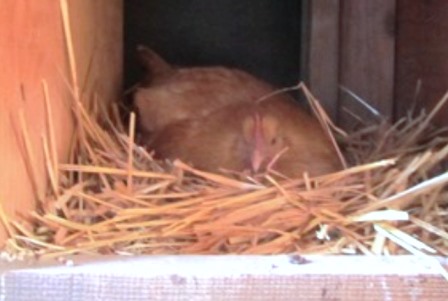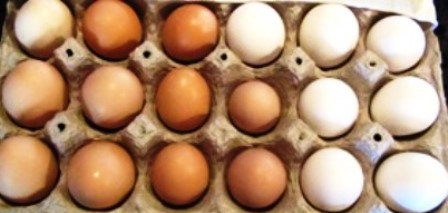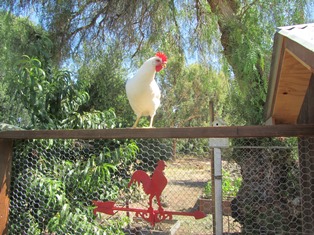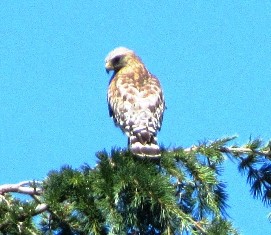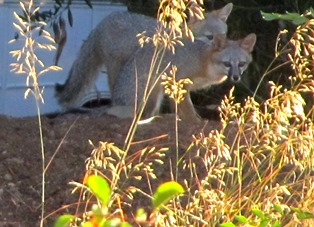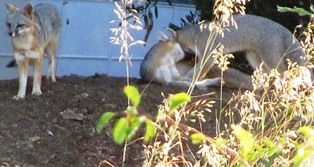Archive for the 'Animals' Category
Big, Blonde Buff-O Goes on the Attack
The yellow-colored Buff Orpington hen seemed so cute when she was all down and a day old.
But six months have passed, the Buff-O has feathered out and gone broody. Today, she showed me a nasty-tempered, cranky hen, with ruffled feathers who will stop at nothing to hatch the clutch of eggs she’s sitting on.
The problem is that some of those eggs in the nesting box aren’t hers, and they’re all unfertilized since we have no rooster.
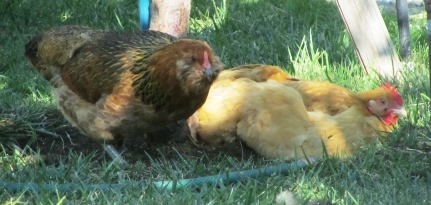
From left to right: Furry Face, the Ameracuana, and Buff-O, the Buff Orpington, when they used to sun themselves together
Buff-O has been sitting on the clutch of eggs for almost three weeks now, barely leaving to eat or drink. But today, she exited the hen house to take dirt bath–that’s how chickens clean themselves. Toss on the dirt, roll in it, then get up and shake like a dog, flinging the dirt in all directions as far as possible.
Before the fight started, all nine of my hens were foraging on our property, except for Buff-O and the shy Ameracauna with the furry face. The latter was in the chicken run, scratching the dirt, minding her own business.
I saw Buff-O walk over and lunge at Furry Face in attack mode. She used her beak to viciously peck Furry Face’s neck and her clawed toes to tear at the poor shy chicken’s back. She seemed more rooster than hen.
I ran for the hose and separated the two with a spray of water. Then, with both out of chicken run and into the yard, I gathered up all those unfertile, soon-to-be-rotten eggs that Buff-O has been trying in vain to hatch, and headed toward the garbage can.
But apparently, tossing those eggs changed nothing. Buff-O is back in the hen house on the nest–albeit, a different nesting box than before. But the straw in the original nesting box is still warm. It’s being occupied by Furry Face. Go figure!
Hypoallergenic Label for Dogs Might Be Misleading
Finding a dog that won’t cause wheezing and sneezing sounds like the perfect solution for families with allergies. But apparently the notion that some breeds–like poodles, labradoodles, terriers, shi tzus, or short- haired dogs–are hypoallergenic isn’t quite the case.
Allergic rhinitis is a common malady that affects 600 million people worldwide (200 million have asthma alongside the rhinitis). Pet allergies bear a significant burden as a common trigger for allergic rhinitis. See http://www.ncbi.nlm.nih.gov/pubmed/20031002
In an article from 2013 in the San Francisco Chronicle, author Kathryn Roethel cited a study by scientists in Detroit, who conducted research involving 173 single-dog homes. See, http://www.kathrynroethel.com/mythbusters/hypoallergenic-dogs-not-allergy-free-study-says
The researchers vacuumed floors of bedrooms in the Detroit area homes. Their goal was to find samples of a protein in pet saliva that caused human allergies to dogs, namely, canis familiaris 1. That allergen was found in 163 of the 173 homes the researchers tested. And dogs (labeled hypoallergenic), according to Roethel “averaged the same amount of the protein as non hypoallergenic dogs.”
Pet owners could reduce the amount of the allergen canis familiaris 1 by having tile and wood floors (which showed slightly less of the allergen in the study) than other floor materials such as carpet.
Also, dog owners could limit levels of the allergen by limiting the rooms that their dog was allowed in.
Keeping dogs outside did not eliminate the presence of canis familiaris 1, although indoor levels could be reduced.
An different study by the same research team indicated the presence of “canis familiaris 1 in approximately half of homes without dogs,” noted author Roethel, “possibly because dogs had lived there in the past.” To read the study, see http://1.usa.gov/1b7F5B4.
The solution is not to get rid of the family dog, but to find ways to reduce exposure to the allergen, canis familiaris 1. Talk with your allergist or family physician about options. And if you are thinking about becoming a dog owner, be aware that the hypoallergenic label might have little to no relevance.
A Broody Hen, A Clutch of Eggs, and No Rooster
My little yellow Buff Orpington {as yet unnamed) has gone broody. I didn’t know this behavior could happen so early in her young life. At 20 weeks, she’s only just started laying eggs. Now all she wants to do is sit on them.
Like an expectant mother, she contentedly sits, apparently anticipating the arrival of her chicklets (in 21 days). I don’t have the heart to tell her that she needed a rendezvous with a rooster to get eggs that will hatch. And, in case she hasn’t noticed, we don’t have a rooster.
She’s become a fixture on the nesting box, forcing the other chickens to lay their eggs in the other two. Buff O. sits on the eggs (who knows how many are under her) with a glazed look in her eyes. If I go near her nesting box, she puffs up and ruffles her feathers like an attack chicken.
She must leave the nest to eat, drink, and poop . . . . but I haven’t witnessed it, so I have put containers of food and water near the nest. I don’t want her losing weight or getting sick during her sit-in.
At first, sensing that she was behaving strangely and fearful that something be wrong with her, I began searching the Internet. Apparently some breeds like Silkies, and Cochins have a tendency to go broody. And, they can go broody more than once during the year. See, http://blog.mypetchicken.com/2012/02/01/what-is-a-broody-hen.
Apparently, dictated by their biology, laying hens decide to sit on a clutch of eggs, even rolling other chickens’ eggs under them if there aren’t enough. The laying hen will rotate her body to redirect heat evenly over the eggs or pluck out her own chest feathers to create more warmth and moisture for the eggs. In the case of my hen, I’m trying to imagine a bare-chested chicken sitting on a clutch of eggs that will never hatch.
Broody hens will even talk to the eggs (and the little chicks growing inside). It’s mommy business they are attending to. However, once a hen has gone broody, she will stop laying. And as for the mommy business, I have no idea how my Buff Orpington will figure out that those eggs she’s so carefully guarding . . . well, they’re just eggs.
If It’s Good Enough for Bill Gates, I Might Try It, Too
On Sunday mornings on our farmette, we almost always have potatoes, assorted cheeses and fresh fruit, along with homemade bread, honey, and a jar of apricot or strawberry jam that I’ve put up during jam season. But organic eggs from my free-range heritage chickens takes center stage, scrambled or poached (my favorite, a la Jacques Pépin and Julia Child), or cooked in an omelet with fresh herbs.
People who can’t eat poached, scrambled, or omelet eggs because of cholesterol concerns or egg allergies often make do without eggs or indulge their omelet craving with egg substitutes. But what about egg-free cookie dough or mayonnaise?
Enter Eco-food innovator, Hampton Creek Foods. The company’s biochemical scientists at work at the three-year-old, San Francisco-based company have come up with an egg substitute that is plant-based. It has already found a perfect plant-based recipe for egg-free mayonnaise and cookie dough.
With its egg substitute, Beyond Eggs, and other products, the company seeks to crack open an industry that produces 1.1 trillion eggs annually.
According to Katie Fehrenbacher, writing last year for Gigaom, Hampton Creek Foods CEO Josh Tetrik says “the food industry is broken.” See, http://gigaom.com/2013/09/11/hampton-creek-now-selling-plant-based-eggs-at-whole-foods-in-california/
Hampton Creek touts its plant-based, egg-free formulas as cheaper, healthier, and more humane. With its emphasis on food technology, Hampton Creek has attracted interest and funding from Silicon Valley venture capitalists and the world’s super-wealthy billionaire Bill Gates and Li Ka-shing, Asia’s richest man.
Earlier this year, Forbes writer Ryan Mac discussed Hampton Creek’s food technology venture that has attracted the interest of Yahoo co-founder Jerry Wang and Li Ka-shing. See, http://www.forbes.com/sites/ryanmac/2014/02/17/egg-replacing-startup-hampton-creek-foods-raises-23-million-from-asias-richest-man-and-yahoo-cofounder-jerry-yang/
In California, foodies can find Hampton Creek’s Beyond Eggs at Whole Foods stores. Those who love the real thing can buy eggs labeled as organic, produced by pastured free-range flocks.
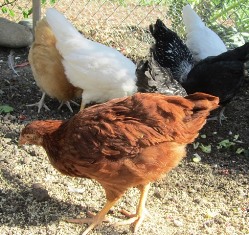
A Rhode Island Red forages with a Buff Orpington, two White Leghorns, a Black Sex Link, and two Silver-laced Wyandottes
According to tests conducted by Mother Earth News,the eggs from free-range pastured chickens have more beta carotine, vitamin A, vitamin E, and Omega-3 fatty acids with less cholesterol and less saturated fat than most store-bought eggs from chickens that weren’t pastured. See, http://www.motherearthnews.com/real-food/free-range-eggs-zmaz07onzgoe.aspx#axzz3CB01GPlj
Sunday mornings on the farmette wouldn’t be the same without fresh eggs from the hen house, but if Bill Gates likes Hampton Creek Foods’ products, I might just give them a try. Still, I’m having a hard time imagining how the taste of an egg substitute from a yellow-pea and canola concoction could rival an organic egg.
They’re Ba-a-c-k!
The sound of the chickens squawking propelled me upright in bed. The sun wasn’t up yet but there was a ruckus going on in the chicken house. And it didn’t sound pretty.
I leaped from bed, staggered to the window, pulled up the blind, and looked out.
The foxes had returned. One stood on its hind legs, pawing at the double layer of poultry wire screwed over the open chicken window.
I yelled, “Get out of there!” hoping the fox would leave . . . but it didn’t. It just made the chickens squawk louder.
Throwing on my robe, I raced to the patio where my red, rubber (indestructible) clogs waited for my feet to slide in. Grabbing the broom and a two-by-four, I raced to the chicken house, yelling all the way.
This time the fox paid attention, but showed no interest in retreating. I waved the broom and pounded my board against the metal garbage can (in which I keep the 25-pound bags of chicken feed). The noise did the trick. Off went the fox to join the other two.
The three disappeared into the wooded acre of land behind our property. Finally, my chickens settled down. I let them out for the day. One deposited her egg–not in the nesting box–but on the ground, as if too freaked out to go back inside the hen house. Well, can you blame her?
A Hawk Drops by to Visit the Chickens
Nightmarish as it seems, I didn’t fear the hawk swooping down from the pine tree onto the fence. Nor did I worry when it perched next to the chicken run this morning.
The poor chickens, who have been visited by foxes and other predators of late, deserve to be safe. To alleviate my own worries about the eight young layers and Mystery (the old Cochin), I’ve stretched poultry wire over the top of the run and strategically placed sheets of corrugated aluminum over potential entrance holes that animals could climb down, dig under, or fly through.
The brazen sharp-shinned hawk wasn’t deterred to see me this morning, but it didn’t approach the top of the run because there is no entry point from above.
Just as quickly as the hawk had landed on the fence, it flew away. The chickens went back running around the enclosed run, testing their own wings as they usually did each morning after being released from the hen house.
My girls are heritage breeds, so retain the flying ability that has been bred out of farm-factory chickens that are meant to only to lay eggs or be sold as meat to consumers.
I’ve lost chickens before to predators and ending up crying for days. I take full responsibility for raising my animals in a humane and loving way and I protect them. It’s the best way. For me, it’s the only way.
Outfoxing the Foxes
The chickens made such a ruckus this morning, I thought they were having trouble with a rodent in the hen house. My architect husband built the sturdy hen house off the ground.
He installed windows for air circulation and to cool off the chicken house at night. Good idea, we thought. Maybe not.
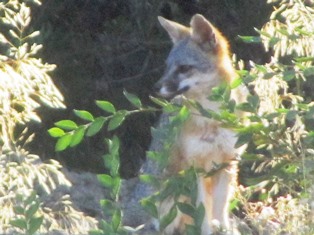
One of three gray foxes that have been checking out the chicken house at dawn and in the late evening
The windows open (to let out the heat) through screens. But foxes and open windows present a clear and present danger for the chickens.
When I first spotted the foxes on the uninhabited acre of land behind our farmette, I put extra poultry wire over the chicken run and over the hen house windows.
Each night, I secure the iron gate between the properties. The foxes were close this morning. I couldn’t say whether or not they’d go over the fence, but I took some shots with my camera before they spooked and left.
To outfox the foxes, I added extra roofing to the chicken run and inspected the fence all around to make sure there were no holes or weakened areas where the foxes could dig under.
We’ve placed a call to the local wildlife shelter and are hopeful that a representative can help us understand why the foxes are in an urban area (maybe in search of water and food during this intense drought) and whether nor not they will rescue the lovely little gray fox family, which is our hope.
Little Foxes on my Front Porch
The heat drove me from bed this morning around 6 a.m. Northern California is in the midst of a triple-digit heat wave and there’s not much relief at night.
I made coffee, as I always do as soon after rising, and peeked out the back sliding glass door. I can see into the chicken house because my husband installed windows. The chickens were still on the roost. I’d have time for a swallow or two of coffee.
Then I heard what sounded like a knock at the front door. Padding across the living room in bare feet, I opened it, half expecting to see my daughter (also an early riser; she likes making runs to Starbucks for her coffee).
It wasn’t my daughter. It was a small fox. The poor thing seemed as startled to see me as I was to see it.
When the fox bounded off the porch, I saw the other two. Yes, there were three–a whole family–in my front yard. Perhaps they came down from the hills of Mount Diablo to search for water or food . . . so back to the chickens I went.
Certain that there was no way for the foxes to get into the chicken run, I let the hens out; gave them food and water. Then, after searching the property for those little foxes, I went back to enjoy my coffee while the sun rose to begin roasting the Bay Area.
Gunshot Triggers Howls and Cackles in the Hood
Farm life isn’t always quiet. Night before last, a shot rang out around 11:00 p.m. It happened after some people in the neighborhood had engaged in a running argument, lasting hours.
My husband and I heard the arguing during our romantic dinner on the patio. His birthday is tomorrow and we celebrate birthdays all week, you see.
Hubby said he knew the sound of gunshots when he heard them. He was even more certain he’d heard the words, “We got to get out of here!” I was tempted to dive under the bed because people on the run with guns . . . well, that could be dangerous.
In the dark, you don’t know what has happened. I write mysteries. I’m thinking, “is there a body on the adjacent property?”
Three uniformed police officers arrive with nightsticks in their duty belts and guns in their holsters. With their flashlights drawn and turned on, they searched for a way into fortress that the neighbor has built or a means to see behind the tarps the neighbor has strung to hide his backyard and sheds.
Over the barking of the neighbor’s pit bull, I heard one officer tell the others, “This is like the Beverly Hillbillies. We’re notifying Code Enforcement.”
Glad it wasn’t our place they were talking about. We’ve been renovating . . . but neatly. Still, there’s the unfinished porch, the pile of lumber . . . .
I watched the erratic beams of their flashlights as they searched. Then . . . here they come, lights bobbing, down our driveway. They want to see if they can penetrate the fortress of the Beverly Hillbillies from another direction. Our house is in close proximity.
My husband went searching for a ladder. Call me silly, but I thought it would be the tall, thin officer, who would climb up. No, that would be too logical. It was the short, chunky one scaling into the heights, disappearing into the elm tree. Did I mention the tree has an almost impenetrable canopy in summer? Not surprising that he couldn’t see anything.
The officers decided on a look-see from the rear. My hubby guided them through a field, past the apiary and chicken house.
Roosting chickens are usually quiet. No doubt, you’ve heard the expression, “Going to bed with the chickens, rising with the rooster.” To say my hens were alarmed might be an understatement. They’d been roused from their slumber and cackled like there was no tomorrow. I realize there’s a bit of irony in the fact that our place is called the Henny Penny Farmette after Chicken Little’s story about the acorn falling on her head. This could have been the sky falling. They cackled like it was.
The deafening cackles agitated the neighbor’s pit bull, whose incessant barking got all the dogs in the hood howling. A fire engine shot by, sirens blaring. I took an aspirin, waited for my husband to return and the officers to leave.
Back in bed, who could sleep? I worried about when about when Code Enforcement might show up to cite the Beverly Hillbillies. Would the officers look over the fence and cite us as well? Code Enforcement aside, a gun-toter could hide behind our pile of porch lumber. We gotta get that porch finished.
But, like I said, it’s my husband’s birthday. He’s feeling romantic this week and not easily pushed. See my conundrum?
The Wait Is Over–Gifts in the Chickens’ Nesting Boxes
Since March 7, the day I brought home eight baby chicks (The White Leghorns and the Silver Laced Wyandottes are two sets of sisters), I’ve been waiting for eggs. Today, I cleaned out the hen house and noticed that instead of three wooden eggs (I put them in the nesting boxes to encourage the hens to lay), there were five.
That means that either one of my White Leghorns laid two eggs or, more likely, each of them made a little deposit in the nesting box.
It’s a cheap thrill, I know, but I thought the egg-laying would start at 16 weeks but, in fact, it took 17 weeks and five days. Now, all that waiting seems almost silly. Hens lay when their DNA and biology tells them to. That’s all there is to it.
It remains to be seen if they will lay an egg each day or if their schedule will be more erratic. I’m not complaining since it’s nice to have fresh eggs any day I find them.
 Facebook
Facebook Goodreads
Goodreads LinkedIn
LinkedIn Meera Lester
Meera Lester Twitter
Twitter





